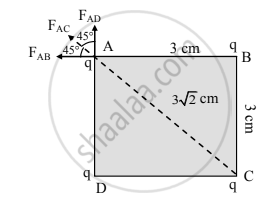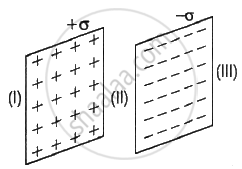Advertisements
Advertisements
Question
Solve numerical example.
Four charges of + 6×10-8 C each are placed at the corners of a square whose sides are 3 cm each. Calculate the resultant force on each charge and show in the direction and a diagram drawn to scale.
Solution
Given: qA = qB = qC = qD = 6 × 10-8 C, a = 3 cm

Magnitude of force on A due to D is,
FAD = `1/(4πε_0)"q"^2/"r"_"AD"^2`
= `(9xx10^9xx(6xx10^-8)^2)/(3xx10^-2)^2`
= 3.6 × 10−2 N
Similarly,
FAB = 3.6 × 10−2 N
FAC = `1/(4πε_0)"q"^2/"r"_"AC"^2`
= `(9xx10^9xx(6xx10^-8)^2)/(3sqrt2xx10^-2)^2`
= 1.8 × 10−2 N
∴ Resultant force on ‘A’
= FAD cos 45 + FAB cos 45 + FAC
`=(3.6xx10^-2xx1/sqrt2)+(3.6xx10^-2xx1/sqrt2) +1.8xx10^-2`
= 6.89 × 10−2 N directed along `vec"F"_"AC"`
The resultant force on each charge will be 6.89 × 10−2 N
APPEARS IN
RELATED QUESTIONS
Choose the correct option.
Which of the following produces uniform electric field?
Answer the following question.
What is a uniform electric field?
A charge +q exerts a force of magnitude -0.2 N on another change -2q. If they are separated by 25.0 cm, determine the value of q.
Solve numerical example.
Calculate the electric field due to a charge of −8.0×10−8 C at a distance of 5.0 cm from it.
A conducting sphere of radius R = 20 cm is given a charge Q = 16 µC. What is `vecE` at centre?
The number of electrons to be put on a spherical conductor of radius 0.1 m to produce an electric field of 0.036 N/C just above its surface is ____________.
An electron at rest is accelerated by a potential 'V1', in uniform field experiences a force 'F1'· When potential is changed to 'V2', the force experienced by the electron gets doubled. The ratio of V1 to V2 is ______.
An electron experiences a force equal to its weight, when placed in an electric field. The intensity of the field will be ______.
Deuteron and `alpha` - particle are put 1 Å apart in air. Magnitude of intensity of electric field due to deuteron at `alpha` - particle is ____________.
The magnitude of point charge due to which the electric field 30 cm away has the magnitude 2 NC-1 will be ____________.
A particle of mass m and charge q is placed at rest in a uniform electric field E and then released, the kinetic energy attained by the particle after moving a distance y will be ______.
A large metal plate of area 1.0 m2 is placed in electric field. The magnitude E of the electric field is 5.5 N/C. What is the magnitude of charge on the plate?
Electric field at the centroid of a triangle carrying q charge at each comer as
Dimensional formula for electrical field is ______
A charged particle (mass m and charge q) moves along X axis with velocity V0. When it passes through the origin it enters a region having uniform electric field `vec"E" = -"E"hat"j"` which extends upto x = d. Equation of path of electron in the region x > d is :

A copper ball of density 8.6 g/cm3, 1 cm in diameter is immersed in oil of density 0.8 glcm3. The charge in µC on the ball, if it remains just suspended in an electric field of intensity 3600 V/m acting in upward direction is ______ µC.
An oil drop of radius 2 mm with a density 3 g cm-3 is held stationary under a constant electric field 3.55 × 105 V m-1 in the Millikan's oil drop experiment. What is the number of excess electrons that the oil drop will process?
Consider g = 9.81 m/s2
The electric field in a region of space is given by, `vec"E"= "E"_"o"hat"i" + 2"E"_"o"hat"j"` where Eo = 100 N/C. The flux of the field through a circular surface of radius 0.02 m parallel to the Y-Z plane is nearly ______.
The expression for electric field intensity at a point outside uniformly charged thin plane sheet is ______. (d is the distance of point from plane sheet)
Consider the following statement about the electric field the intensity and the electric potential.
- The electric field intensity due to a charged spherical shell is inversely proportional to the square of its radius.
- The electric potential due to a point charge is inversely proportional to the distance between the charge and the point.
Which of the following configuration of electric lines of force is not possible?
If the potential in a region of the electric field is expressed as V(x, y, z) = 2xy + 3zx - yz, then the electric field at point (0, 1, 1) is ______.
Find the electric field in region II as in figure shown.

